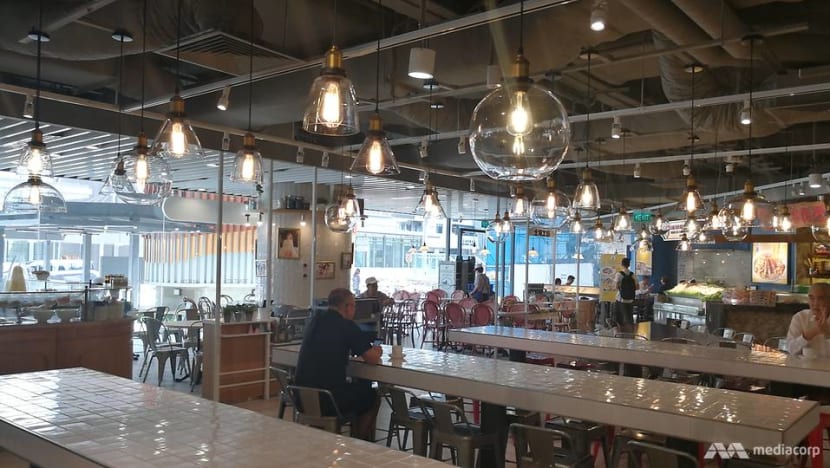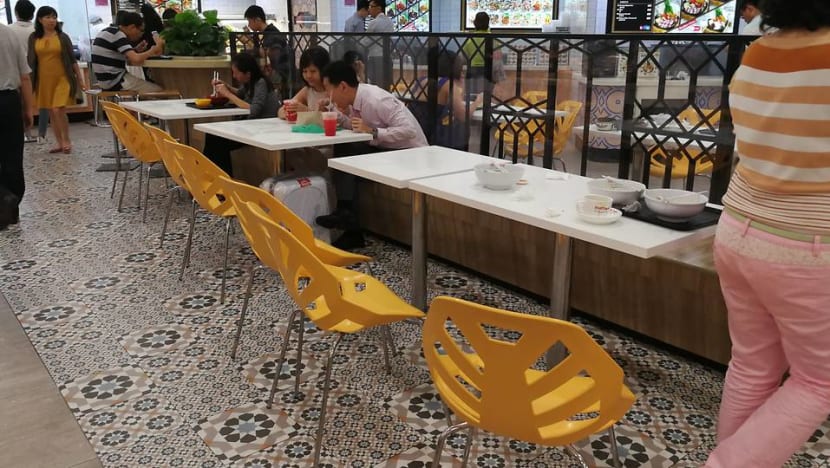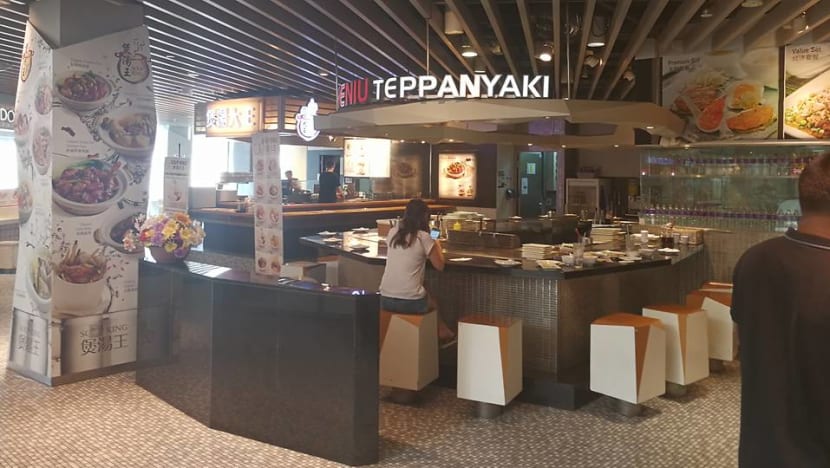Evolving food courts: Blending hawker fare and hipster cafe

Food courts now are a far cry from those of yester years. They have chic interiors, modern light fittings, and even hipster signs sometimes. This is Food Republic's Bras Basah outlet. (Photo: Jalelah Abu Baker)
SINGAPORE: 'Hello You Foodie' screams a brightly lit, partly-neon sign at diners, who are also greeted by designer lights and retro tiles.
Customers might be fooled into thinking that they are walking into a chic, new cafe. Instead, the snazzy interior is in a food court operated by Food Republic. Other food court chains like NTUC Foodfare and Kopitiam feature similar designer fittings and bright colours.
While food courts were once generally positioned as a simple dining option offering basic dishes, they are increasingly taking on a more sophisticated identity. They were a step up from hawker centres and coffee shops, but in recent years, the gap has widened as many food courts have raised their technology, decor and offerings by several notches.
Food Republic, which manages 15 food courts, has outlets with different themes. For example, Vivocity has a 1900s village theme while the Wisma Atria outlet is modelled to resemble a Singapore food street of the 1960s. Food court chain NTUC Foodfare also has themed outlets among its 13 food courts. Its Kallang Wave Mall outlet has a sports theme, while its Khoo Teck Puat Hospital outlet has a scenic garden concept.

Kopitiam, which operates more than 50 food courts, said it has themed outlets such as Gourmet Heritage in Bedok, and the upcoming KopiTech in the new Funan.
“Food court decor has become more sophisticated over the years, to meet rising customers’ expectations on what a food court ... should look and feel like,” a Kopitiam spokesman said.
Such efforts to spruce up food courts have not gone unnoticed.
FOOD COURTS ARE BRIGHTER, CLEANER
Housewife Jasmine Chan, 49, eats at food courts three to four times a week. Speaking to Channel NewsAsia outside the Kopitiam outlet at Plaza Singapura after having a vegetarian meal that cost S$4.80, she said: “I find the lighting brighter now, and that does make the place look better and cleaner. There’s also more variety here than in coffee shops, and I find food here affordable.”
Retired couple Mr A.S Chia, 70, and Mrs Irene Chia, 60, have started to spend more of their spare time at food courts. When Channel NewsAsia visited the Food Republic outlet in 313@Somerset at about 4pm on a Thursday, Mr Chia was reading the newspapers while his wife sipped on a drink.
“This is one of my favourite food courts. It’s quiet, especially at this time,” said Mrs Chia.
“There’s no rush for me to leave. If I was at a restaurant or a coffee shop, I couldn't just sit there,” Mr Chia chimed in.
Other than the space to take a break, Mrs Chia said she also enjoyed her meal from a Japanese store. The couple said that food courts have “improved amazingly” over the years and find that they are an affordable place to dine at and pass time.
Having said that, Mrs Chia also pointed out that prices are sometimes high, with her meal from a Japanese stall costing S$7. However, she said that the air conditioning and the ambience made it worth the price.

USING TECHNOLOGY TO EASE MANPOWER SHORTAGE, PROVIDE CONVENIENCE
As well as innovative decor, food courts have been introducing new technologies to make things easier for themselves and patrons. Food Republic has implemented contactless and mobile payment options. These give greater convenience to customers, especially tourists and working professionals, as they need not fumble with cash, its general manager Andy Kiu said.
Self-ordering and self-payment systems in Straits Food Village at Changi Airport Terminal 2 helped overcome a shortage in manpower, said Mr Vincent Tan, managing director of Select Group which runs the food court. Kopitiam customers can also skip the queue by ordering their drinks and breakfast sets via self-order kiosks introduced in 2016. The chain has also taken technology one step further by launching mobile payment app K-pay in May this year. The app offers patrons a 10 per cent discount off food and beverage items.
Mr Tan from Select Group said that at Tanglin Food Hall, a 40-metre conveyor belt transports used plates from the collection point to the washing area, eliminating the need to manually do the task. A similar system is used in Kopitiam, a spokesman said. At Kopitiam, robotic vacuum cleaners are also used to clean and sanitise floors, decreasing man-hours by at least half.
“High rental and shortage of manpower will continue to challenge the industry and we will have to overcome with innovation ideas and enhanced productivity,” Mr Tan said.
MORE VARIETY, MORE INTERNATIONAL CUSTOMERS
The evolution of food courts also extends to their core offerings, with a much greater range of cuisines on offer. Whatever their mood, food court patrons are likely to find something that suits their palate. Food court chains now sell everything from Korean to Vietnamese to Mexican cuisine, a far cry from the focus on local dishes that used to be prevalent.
Eddie Lim, the director of Li Xin TeoChew Fishball Noodles who opened his stall in 2009 at Food Republic, said that 10 years ago, food courts focused on serving good quality food local hawker fare, and nothing “particularly adventurous”.
“Over the years, local food court fare has diversified, featuring more international cuisine selections. Besides the usual local dishes, such as fishball noodles and Hokkien mee, we’re beginning to see more innovative Japanese, Korean and Thai cuisine available in food courts at an affordable prices,” he said.
While most meals at food courts can still be bought for less than S$10, NTUC Foodfare has gone to extra lengths to keep prices affordable. “Stallholders who wish to operate in our food courts and coffee shops are required to submit their food prices for our review. We will then evaluate them against the mode price of the same food type sold at other similar food courts to ensure that the prices are not unreasonable and remain affordable,” a spokesman said.
To add to an already large array of cuisines, some food courts also lease out their space to restaurants within their premises, and they come with their own sitting areas. Popular food chains like Pepper Lunch and Monster Curry also have outlets in food courts.
With more payment options and offerings to cater to all palates, food courts are seeing a growth in foreign customers.

“Our efforts to provide customers with a seamless dining experience have attracted a growing number of international visitors, and acquired us a CTRIP Food Award 2016/2017 and a TripAdvisor Certificate of Excellence,” Mr Kiu from Food Republic said. Similarly, Select Group’s Mr Tan said that there is an increase in the number of expatriates and tourists visiting his eight food courts.
FOOD COURTS HERE TO STAY: ACADEMICS
In 1985, the first food court, Picnic, was established at Scotts Shopping Centre along Scotts Road. It was considered revolutionary, as it offered affordable hawker fare in a comfortable, air-conditioned environment, and became wildly popular.
This prompted the establishment of more food courts in shopping malls, housing estates and industrial parks. As early as 1998, Kopitiam experimented with themed food courts, with a jungle-themed food court at Plaza Singapura.
Food courts are now an integral part of Singapore's F&B ecosystem, and academics said that they are here to stay.
“They have allowed hard-working entrepreneurs to preserve and serve their traditional recipes. Also, they serve as an informal gathering place that helps build a strong sense of community,” said Visiting Professor Sherri Kimes from the Department of Decision Sciences, National University of Singapore Business School.
“With their variety and affordability, food courts will continue to be a mainstay on Singapore’s culinary landscape. Dining at food courts has become a way of life in Singapore, hence there is reason to believe that food courts will continue to thrive amidst future economic uncertainty,” said Dr Denis Ang, Course Manager of Diploma in Food & Beverage Business at Nanyang Polytechnic.
Retiree John Tan, 69, for one, is pleased that food courts are here to stay. "Some of these food courts are top of the range, but still, they cater to people with various budgets," said Mr Tan, who was taking a respite from the sun at Food Republic's Bras Basah outlet.
"The ambience is better here than in a coffee shop, and the quality of food is also comparable."














